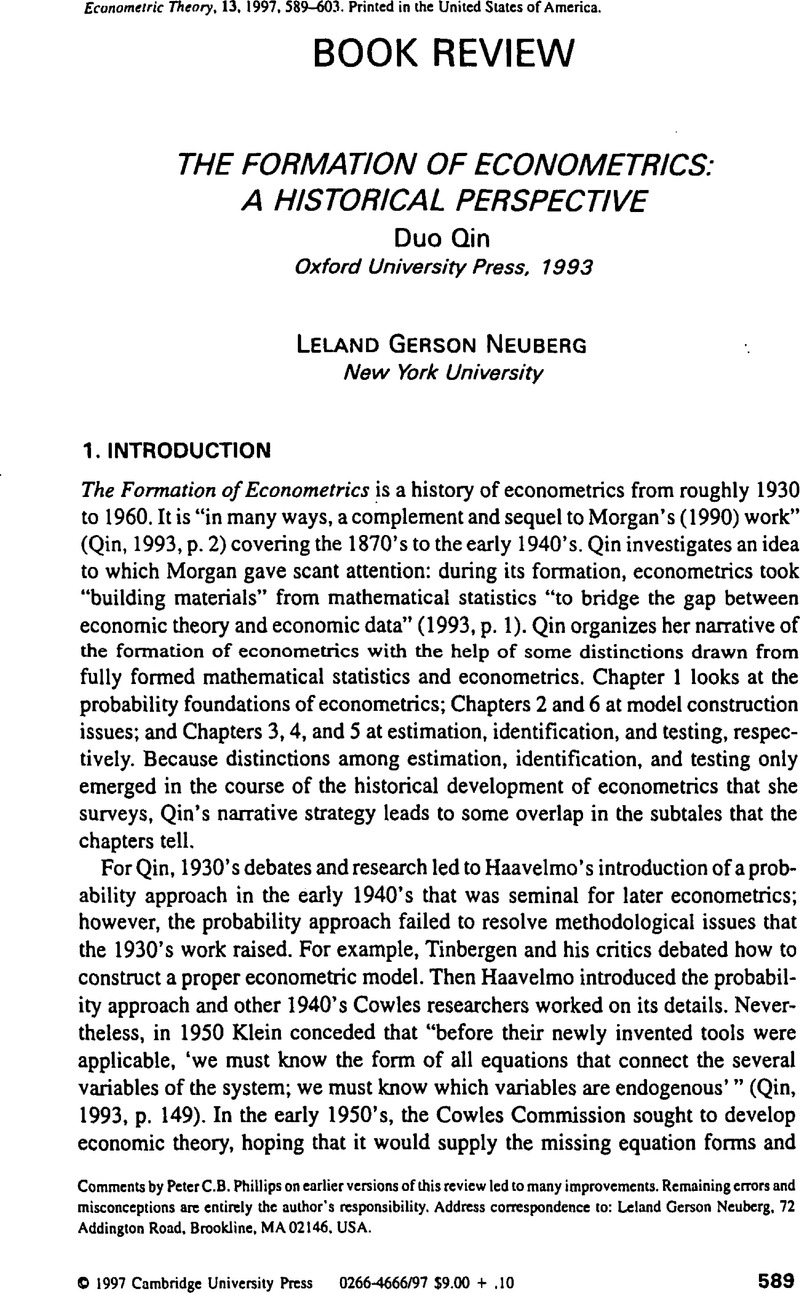No CrossRef data available.
Article contents
The Formation of Econometrics: A Historical Perspective Duo Qin Oxford University Press, 1993
Published online by Cambridge University Press: 11 February 2009
Abstract
An abstract is not available for this content so a preview has been provided. Please use the Get access link above for information on how to access this content.

- Type
- Book Review
- Information
- Copyright
- Copyright © Cambridge University Press 1997
References
REFERENCES
Bergstrom, A.R.
(1962) The exact
sampling distributions of least squares and
maximum likelihood estimators of the marginal
propensity to consume.
Econometrica
30,
480–490.10.2307/1909891CrossRefGoogle Scholar
Card, D.
& Krueger, A.B.
(1995) Myth and Measurement:
The New Economics of the Minimum Wage.
Princeton, New
Jersey: Princeton
University Press.Google Scholar
Chemoff, H.
& Rubin, H.
(1953) Asymptotic properties of
limited-information estimates under generalized
conditions. In Hood, W.C.
& Koopmans, T.C.
(eds.). Studies in Econometric
Method, Cowles Commission Monograph 14,
pp. 200–212.
New York:
Wiley.Google Scholar
Fisher, R.A.
(1922) On the mathematical
foundations of theoretical statistics. Reprinted in
Kotz, S.
& Johnson, N.L.
(eds.) (1992), Breakthroughs in
Statistics, vol. I:
Foundations and Basic Theory, pp.
11–44.
New York:
Springer-Verlag.Google Scholar
Haavelmo, T.
(1943) The statistical
implications of a system of simultaneous
equations.
Econometrica
11,
1–12.10.2307/1905714CrossRefGoogle Scholar
Haavelmo, T.
(1944) The probability approach in
econometrics [whole supplement].
Econometrica 12.Google Scholar
Koopmans, T.C.
& Hood, W.C.
(1953) The estimation of simultaneous
linear economic relationships. In Hood, W.C.
& Koopmans, T.C.
(eds.), Studies in Econometric
Method, Cowles Commission Monograph 14,
pp. 112–199.
New York:
Wiley.Google Scholar
Le
Cam, L.
(1953) On some
asymptotic properties of maximum likelihood
estimates and related Bayes'
estimates. University of
California Publications in Statistics
1,
277–329.Google Scholar
Lehmann, E.L.
(1992) Introduction to Neyman and
Pearson (1933) “On the problem of the
most efficient tests of statistical hypotheses.” In
Kotz, S.
& Johnson, N.L.
(eds.) (1992), Breakthroughs in
Statistics, vol. I:
Foundations and Basic Theory, pp.
67–72.
New York:
Springer-Verlag.10.1007/978-1-4612-0919-5_5CrossRefGoogle Scholar
Mann, H.B.
& Wald, A.
(1943) On the
statistical treatment of linear stochastic
difference equations.
Econometrica
11,
173–220.10.2307/1905674CrossRefGoogle Scholar
Morgan, M.S.
(1990) The History of
Econometric Ideas. New
York: Cambridge
University Press.10.1017/CBO9780511522109CrossRefGoogle Scholar
Neyman, J.
& Pearson, E.S.
(1933) On the problem of the most
efficient tests of statistical hypotheses. Reprinted
in Kotz, S.
& Johnson, N.L.
(eds.) (1992), Breakthroughs in
Statistics, vol. I:
Foundations and Basic Theory, pp.
73–108.
New York:
Springer-Verlag.Google Scholar
Tinbergen, J.
(1939) Statistical Testing of
Business-Cycle Theories I: A Method and Its
Application to Investment Activity.
Geneva:
League of
Nations.Google Scholar
Wald, A.
(1941) Asymptotically
most powerful tests of statistical
hypotheses. Annals of
Mathematical Statistics
12,
1–19.10.1214/aoms/1177731783CrossRefGoogle Scholar
Wald, A.
(1943) Test of
statistical hypotheses concerning several
parameters when the number of observations is
large. Transactions of the
American Mathematical Society
54,
426–482.10.1090/S0002-9947-1943-0012401-3CrossRefGoogle Scholar
Wald, A.
(1949) Note on the
consistency of the maximum likelihood
estimator. Annals of
Mathematical Statistics
20,
595–601.10.1214/aoms/1177729952CrossRefGoogle Scholar




